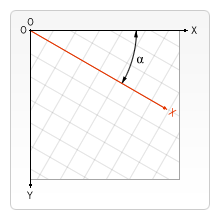CanvasRenderingContext2D: rotate() method
Baseline Widely available
This feature is well established and works across many devices and browser versions. It’s been available across browsers since July 2015.
The
CanvasRenderingContext2D.rotate()
method of the Canvas 2D API adds a rotation to the transformation matrix.
Syntax
rotate(angle)

Parameters
angle-
The rotation angle, clockwise in radians. You can use
degree * Math.PI / 180to calculate a radian from a degree.
The rotation center point is always the canvas origin. To change the center point, you
will need to move the canvas by using the
translate() method.
Return value
None (undefined).
Examples
Rotating a shape
This example rotates a rectangle by 45°. Note that the center of rotation is the top-left corner of the canvas, and not a location relative to any shape.
HTML
<canvas id="canvas"></canvas>
JavaScript
const canvas = document.getElementById("canvas");
const ctx = canvas.getContext("2d");
// Point of transform origin
ctx.arc(0, 0, 5, 0, 2 * Math.PI);
ctx.fillStyle = "blue";
ctx.fill();
// Non-rotated rectangle
ctx.fillStyle = "gray";
ctx.fillRect(100, 0, 80, 20);
// Rotated rectangle
ctx.rotate((45 * Math.PI) / 180);
ctx.fillStyle = "red";
ctx.fillRect(100, 0, 80, 20);
// Reset transformation matrix to the identity matrix
ctx.setTransform(1, 0, 0, 1, 0, 0);
Result
The center of rotation is blue. The non-rotated rectangle is gray, and the rotated rectangle is red.
Rotating a shape around its center
This example rotates a shape around its center point. To do this, the following steps are applied to the matrix:
- First,
translate()moves the matrix's origin to the shape's center. rotate()rotates the matrix by the desired amount.- Finally,
translate()moves the matrix's origin back to its starting point. This is done by applying the values of the shape's center coordinates in a negative direction.
HTML
<canvas id="canvas"></canvas>
JavaScript
The shape is a rectangle with its corner at (80, 60), a width of 140, a height of 30. Its horizontal center is at (80 + 140 / 2), or 150. Its vertical center is at (60 + 30 / 2), or 75. Thus, the center point is at (150, 75).
const canvas = document.getElementById("canvas");
const ctx = canvas.getContext("2d");
// Non-rotated rectangle
ctx.fillStyle = "gray";
ctx.fillRect(80, 60, 140, 30);
// Matrix transformation
ctx.translate(150, 75);
ctx.rotate(Math.PI / 2);
ctx.translate(-150, -75);
// Rotated rectangle
ctx.fillStyle = "red";
ctx.fillRect(80, 60, 140, 30);
Result
The non-rotated rectangle is gray, and the rotated rectangle is red.
Specifications
| Specification |
|---|
| HTML # dom-context-2d-rotate-dev |
Browser compatibility
BCD tables only load in the browser
See also
- The interface defining this method:
CanvasRenderingContext2D